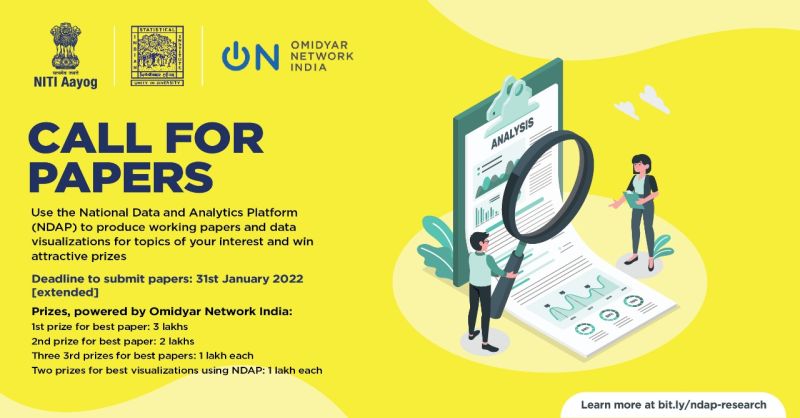NDAP Research Awards for Masters and PhD Students : Call for Applications

![]()
Deadline is extended to 𝟑𝟏𝐬𝐭 𝐉𝐚𝐧𝐮𝐚𝐫𝐲 𝟐𝟎𝟐𝟐.
The National Data & Analytics Platform (NDAP) is an initiative of the Data Management & Analysis Vertical, NITI Aayog. Omidyar Network India and Indian Statistical Institute Delhi have partnered with NITI Aayog to ensure the development and delivery of NDAP as a quality public good. The objective of this platform is to serve as a single point for accessing data across all Ministries of the Government of India combined with intuitive visualization and self-service analytics. The platform is currently under development and is scheduled for a public release in early 2022. NDAP seeks to set itself apart from other existing open data platforms by not just publishing data, but centering the experience of the data user and seeking to mitigate the key challenges in our data ecosystem. NDAP aims to become a one-stop platform for high-quality, easy-to-access datasets from across the government.
About the Research Awards
As NDAP nears its public launch, NITI Aayog, in collaboration with the Indian Statistical Institute Delhi and Omidyar Network India, is inviting Masters and PhD students from top tier academic institutions to conduct research using data on NDAP and produce a working paper as the final output. Researchers may combine data from NDAP with other datasets that are available to them for this purpose. The following awards, powered by Omidyar Network India, will be provided:
● First prize for the best research paper: 3,00,000 INR
● Second prize for the best research paper: 2,00,000 INR
● Three Third prizes: 1,00,000 INR each
● Two prizes for best visualizations using NDAP tools: 1,00,000 INR each
Candidates must be based in India, pursuing a Masters or PhD degree in Economics, Public Policy, Sociology, Political Science, Mathematics, Statistics, Social Work or related fields. They are expected to have the capacity to undertake rigorous research during the research period. At the end of the research period, the applicants are expected to produce a high-quality working paper of 1500-2000 words, with the top 5 to be published on NDAP’s website. To apply, please refer to the “Application Procedure” section below. Interested participants are required to inform NDAP of their intent to participate by filling the form linked in the Application Procedure section below by 23:59 IST on 20th December 2021. Interested participants will be provided access to NDAP by 22nd December 2021. The deadline for submission of final papers is 17 th January 2022.
Research submissions will be evaluated using the following criteria:
1. Relevance to policy making
2. Use of data available on NDAP
3. Rigorous and sound methodology, and
4. Coherent and well thought through output
The evaluations will be done by a committee of experts. The committee’s decisions will be final and binding.
Application Procedure
Interested Masters and PhD students should submit the filled NDAP Research Awards – Application form by 23:59 IST on 20th December 2021.
Late applications will not be considered. After submitting your application, you will receive a short acknowledgement and access to NDAP. For any questions, please get in touch with the contact person from NDAP’s PMU team for any queries or questions you might have. To learn more about NDAP, please attend the demo of NDAP being hosted on 02 December. Details of the event can be found in the “Meeting slot” section below.
Additional details
I. Meeting Slots –
We are excited to speak to you and provide more details on NDAP. Please join us for a demo of the platform at the following times:
● Slot I 6:30 to 7:30 pm IST on 13 December, 2021. RSVP here.
II. Relevant Documents –
If you want to know more about NDAP, please refer to the following documents
● Official Press Release
● NDAP’s Contribution to India’s Data Ecosystem
● NDAP Data Standardization
III. Type of expected outputs
● Working Paper: A draft working paper that can be considered for submission to an academic journal. Content for a working paper must include a main report, annexes, and a bibliography, and must be suitable for publication on NDAP. A typical final paper may include the following:
○ Introduction detailing the purpose of the research, the intervention, evaluation
○ Questions, and policy significance,
○ Literature review,
○ The model,
○ Evaluation design,
○ Sampling design,
○ Data collection,
○ Results,
○ Policy implications and recommendations, and
○ Conclusion


